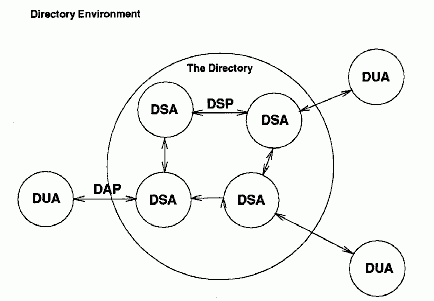
When present in a DCE cell, GDS can serve two basic functions. First, it can provide a high-level, worldwide directory service by tying together independent DCE cells. Second, it can be used as an additional directory service to CDS for storing object names and attributes in a central place.
The GDS database contains information that can be distributed over several GDS servers. In addition, copies of information can be stored in multiple GDS servers, and the information can also be cached locally. The unit of replication in GDS is the directory entry; whole subtrees can be also replicated.
The information belonging to the DIB is shared between several Directory Service Agents (DSAs). A DSA is a process that runs on a GDS server machine and manages the GDS database. DSAs cooperate to perform directory service operations, with each DSA knowing a fraction of the total directory information, as shown in the following figure. DSAs are a combination of local database functions and a remote interface to the clients of users and other DSAs. DSAs can cooperate to execute operations. This cooperation often involves the navigation of operations through the network.
The Relationship Between the DSA and the DUA

Users access the directory via Directory User Agents (DUAs). DUAs make requests of DSAs on behalf of users requesting directory service operations. The manner in which DUAs communicate with DSAs is defined by the X.500 standard. For communications between DUAs and DSAs, the directory access protocol (DAP) is defined. For communications between DSAs in a distributed directory, the standard defines the directory system protocol (DSP).
More:
The Directory User Agent Cache